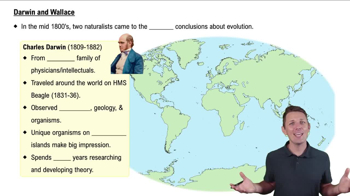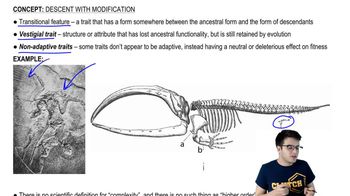Table of contents
- 1. Introduction to Biology2h 42m
- 2. Chemistry3h 40m
- 3. Water1h 26m
- 4. Biomolecules2h 23m
- 5. Cell Components2h 26m
- 6. The Membrane2h 31m
- 7. Energy and Metabolism2h 0m
- 8. Respiration2h 40m
- 9. Photosynthesis2h 49m
- 10. Cell Signaling59m
- 11. Cell Division2h 47m
- 12. Meiosis2h 0m
- 13. Mendelian Genetics4h 44m
- Introduction to Mendel's Experiments7m
- Genotype vs. Phenotype17m
- Punnett Squares13m
- Mendel's Experiments26m
- Mendel's Laws18m
- Monohybrid Crosses19m
- Test Crosses14m
- Dihybrid Crosses20m
- Punnett Square Probability26m
- Incomplete Dominance vs. Codominance20m
- Epistasis7m
- Non-Mendelian Genetics12m
- Pedigrees6m
- Autosomal Inheritance21m
- Sex-Linked Inheritance43m
- X-Inactivation9m
- 14. DNA Synthesis2h 27m
- 15. Gene Expression3h 20m
- 16. Regulation of Expression3h 31m
- Introduction to Regulation of Gene Expression13m
- Prokaryotic Gene Regulation via Operons27m
- The Lac Operon21m
- Glucose's Impact on Lac Operon25m
- The Trp Operon20m
- Review of the Lac Operon & Trp Operon11m
- Introduction to Eukaryotic Gene Regulation9m
- Eukaryotic Chromatin Modifications16m
- Eukaryotic Transcriptional Control22m
- Eukaryotic Post-Transcriptional Regulation28m
- Eukaryotic Post-Translational Regulation13m
- 17. Viruses37m
- 18. Biotechnology2h 58m
- 19. Genomics17m
- 20. Development1h 5m
- 21. Evolution3h 1m
- 22. Evolution of Populations3h 52m
- 23. Speciation1h 37m
- 24. History of Life on Earth2h 6m
- 25. Phylogeny2h 31m
- 26. Prokaryotes4h 59m
- 27. Protists1h 12m
- 28. Plants1h 22m
- 29. Fungi36m
- 30. Overview of Animals34m
- 31. Invertebrates1h 2m
- 32. Vertebrates50m
- 33. Plant Anatomy1h 3m
- 34. Vascular Plant Transport1h 2m
- 35. Soil37m
- 36. Plant Reproduction47m
- 37. Plant Sensation and Response1h 9m
- 38. Animal Form and Function1h 19m
- 39. Digestive System1h 10m
- 40. Circulatory System1h 57m
- 41. Immune System1h 12m
- 42. Osmoregulation and Excretion50m
- 43. Endocrine System1h 4m
- 44. Animal Reproduction1h 2m
- 45. Nervous System1h 55m
- 46. Sensory Systems46m
- 47. Muscle Systems23m
- 48. Ecology3h 11m
- Introduction to Ecology20m
- Biogeography14m
- Earth's Climate Patterns50m
- Introduction to Terrestrial Biomes10m
- Terrestrial Biomes: Near Equator13m
- Terrestrial Biomes: Temperate Regions10m
- Terrestrial Biomes: Northern Regions15m
- Introduction to Aquatic Biomes27m
- Freshwater Aquatic Biomes14m
- Marine Aquatic Biomes13m
- 49. Animal Behavior28m
- 50. Population Ecology3h 41m
- Introduction to Population Ecology28m
- Population Sampling Methods23m
- Life History12m
- Population Demography17m
- Factors Limiting Population Growth14m
- Introduction to Population Growth Models22m
- Linear Population Growth6m
- Exponential Population Growth29m
- Logistic Population Growth32m
- r/K Selection10m
- The Human Population22m
- 51. Community Ecology2h 46m
- Introduction to Community Ecology2m
- Introduction to Community Interactions9m
- Community Interactions: Competition (-/-)38m
- Community Interactions: Exploitation (+/-)23m
- Community Interactions: Mutualism (+/+) & Commensalism (+/0)9m
- Community Structure35m
- Community Dynamics26m
- Geographic Impact on Communities21m
- 52. Ecosystems2h 36m
- 53. Conservation Biology24m
21. Evolution
Introduction to Evolution and Natural Selection
Problem 13
Textbook Question
Most mice living on the mainland of Florida are brown, but the mice that live on the sand dunes of the barrier islands have white fur. The differences in color are heritable, determined by genes such as MC1R. It is intuitive that the light color of beach-dwelling mice is an adaptation for blending into their environment—and thus evading predators. Apply Darwin's four postulates to a population of mice living on sand dunes in coastal Florida.
 Verified step by step guidance
Verified step by step guidance1
Identify the variation in the population: Observe the population of mice and note any differences in traits, such as fur color, size, or behavior. For example, some mice may have lighter fur while others have darker fur.
Determine heritability of traits: Establish whether the observed variations in traits, such as fur color, are heritable. This means that the trait can be passed from parents to offspring through genetic inheritance.
Assess differential survival and reproduction: Analyze how the different traits affect the mice's ability to survive and reproduce in their environment. For instance, mice with fur color that blends with the sand dunes may be less visible to predators, increasing their chances of survival and reproduction.
Evaluate the non-random survival and reproduction: Consider how the environment influences which traits are advantageous. In this case, the sand dunes may favor mice with lighter fur, leading to a higher survival rate for these individuals compared to those with darker fur.
Conclude with natural selection: Understand that over time, the advantageous traits (e.g., lighter fur) become more common in the population due to natural selection, as these traits increase the likelihood of survival and reproduction in the specific environment of the sand dunes.
 Verified video answer for a similar problem:
Verified video answer for a similar problem:This video solution was recommended by our tutors as helpful for the problem above
Video duration:
3mPlay a video:
Was this helpful?
Key Concepts
Here are the essential concepts you must grasp in order to answer the question correctly.
Darwin's Four Postulates
Darwin's four postulates are the foundation of the theory of natural selection. They include: variation among individuals in a population, inheritance of traits, differential survival and reproduction, and the influence of traits on survival and reproduction. These principles explain how populations evolve over time as advantageous traits become more common.
Recommended video:

Darwin and Wallace
Variation in Populations
Variation refers to the differences in physical traits among individuals within a population. In the context of mice living on sand dunes, variation might include differences in fur color, size, or behavior. This diversity is crucial for natural selection, as it provides the raw material for evolution, allowing some individuals to be better suited to their environment.
Recommended video:

Sources of Genetic Variation
Adaptation to Environment
Adaptation is the process by which a species becomes better suited to its environment through natural selection. For mice in coastal Florida, adaptations might include fur color that blends with the sandy environment, enhancing their survival by reducing predation. Over time, these advantageous traits become more prevalent in the population, demonstrating the power of natural selection.
Recommended video:

Adaptive Radiation

 4:58m
4:58mWatch next
Master Evolution and Natural Selection with a bite sized video explanation from Jason
Start learningRelated Videos
Related Practice
































